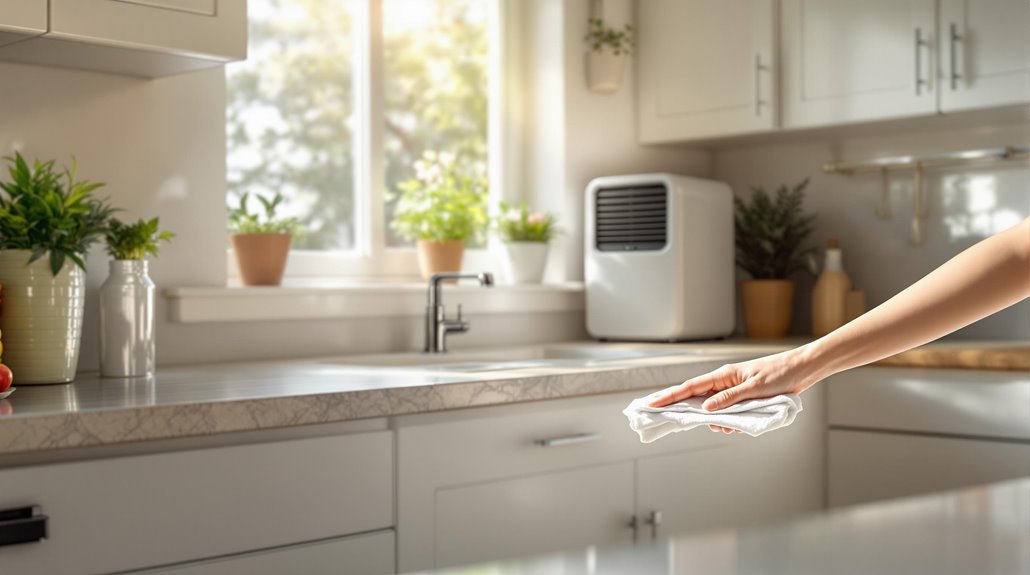To prevent mold growth in your home, start by controlling moisture levels. Use dehumidifiers in damp areas and fix leaks promptly. Verify proper ventilation by using exhaust fans and opening windows regularly. Keep surfaces clean and dry by promptly cleaning spills and using mold-resistant cleaning products. Manage drainage indoors and outdoors to direct water away from your home's foundation. Finally, reduce clutter to improve airflow and eliminate organic materials that mold thrives on. Implementing these tips will effectively minimize mold risk. There's more you can do to improve your home's mold prevention strategy.
Key Takeaways
- Control moisture levels by using dehumidifiers and promptly fixing leaks to keep humidity below 50%.
- Improve ventilation by using exhaust fans and opening windows daily to promote airflow and reduce humidity.
- Maintain clean and dry surfaces by regularly dusting, mopping, and immediately drying wet items to prevent mold growth.
- Respond quickly to water damage by drying affected areas and disinfecting surfaces to eliminate any mold spores.
- Regularly inspect gutters and drainage systems to prevent water accumulation around your home's foundation.
Control Moisture Levels
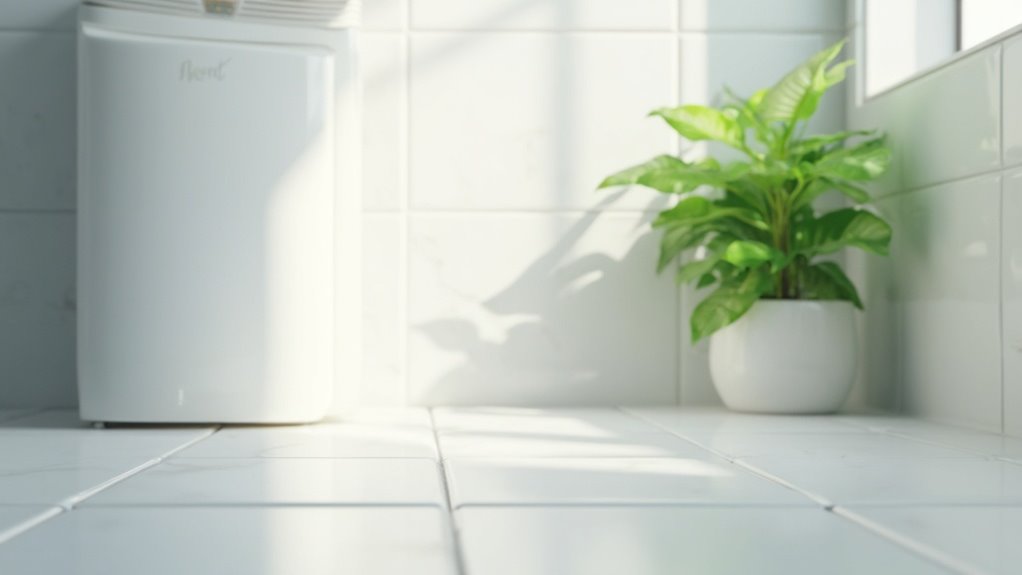
To effectively control moisture levels in your home, you should focus on implementing several practical measures that directly target humidity and water accumulation. Start by utilizing dehumidifiers in high-humidity areas like basements and bathrooms. These devices actively remove excess moisture from the air, making conditions less favorable for mold growth. Verify you choose a unit with the right size and capacity for the space.
Next, promptly fix any leaks to prevent moisture buildup. Regularly inspect plumbing, roofs, and drainage systems around your home. Addressing water issues immediately helps keep your environment dry and healthy. It's vital to dry wet areas within 24-48 hours to mitigate mold risk. Mold can begin to grow within 24 to 48 hours after water exposure, highlighting the urgency of addressing moisture issues quickly. Maintaining proper ventilation is also essential to reduce humidity levels and prevent mold from establishing.
Incorporate moisture sensors to monitor humidity levels effectively. These devices can alert you when humidity rises, allowing for timely intervention. Furthermore, maintain your air conditioning systems; they help remove moisture as they cool. Regular maintenance, such as cleaning filters and checking drain lines, guarantees ideal humidity control. Finally, consider using mold-resistant building materials in moisture-prone areas to further safeguard your home against mold.
Improve Ventilation
To prevent mold growth, you need to improve ventilation in your home. Start by using exhaust fans effectively in areas like kitchens and bathrooms to expel humid air and bring in fresh air. Moreover, enhancing air circulation with ceiling fans and strategically placed windows can greatly reduce moisture levels and create a healthier living environment. Additionally, maintaining damp environments can significantly promote mold and mildew growth, so it's essential to keep humidity levels in check.
Use Exhaust Fans Effectively
Effective use of exhaust fans can greatly reduce moisture buildup in your home, helping to prevent mold growth. These fans are critical in high-moisture areas like bathrooms and kitchens, where mold thrives. To maximize their effectiveness, consider the following:
- Choose the Right Exhaust Fan Types: Select fans based on room size, guaranteeing you have at least 1 CFM per square foot. Powerful bathroom fans and range hood exhaust fans for kitchens are fundamental.
- Proper Fan Installation: Install fans near the ceiling to effectively capture and expel moist air. Verify proper insulation around the fan to prevent condensation.
- Adopt Best Practices: Always run your exhaust fans during and after showering or cooking. Keep them on for at least 20 minutes post-activity to clear residual moisture. Close all windows and doors to boost their efficiency.
Regular maintenance is crucial; check filters and inspect fans to confirm they're functioning correctly. By effectively utilizing exhaust fans, you can considerably improve indoor air quality and reduce the risk of mold-related health issues in your home.
Enhance Air Circulation
Enhancing air circulation in your home is crucial for preventing mold growth and improving overall indoor air quality. To maximize natural airflow, open your windows daily for at least 5-20 minutes. This simple act allows fresh air to circulate while reducing indoor pollutants. Create a cross breeze by opening windows on opposite sides of your house, allowing moisture and humidity to escape effectively. Nonetheless, be mindful of outdoor air quality; avoid opening windows during high humidity or pollution.
Incorporating effective ventilation strategies can further improve airflow. Install ceiling fans to circulate air, especially if you set them to counterclockwise in summer. Whole-house fans can likewise be beneficial—just verify windows or doors are open to promote airflow. Consider implementing Energy Recovery Ventilation (ERV) or Heat Recovery Ventilation (HRV) systems to maintain temperature balance while minimizing energy loss.
Finally, manage humidity levels between 30-60% to inhibit mold growth. Use dehumidifiers in damp areas like basements and confirm proper ventilation in moisture-generating spaces like kitchens and bathrooms. By enhancing air circulation, you create a healthier environment, greatly reducing mold risks.
Maintain Clean and Dry Surfaces
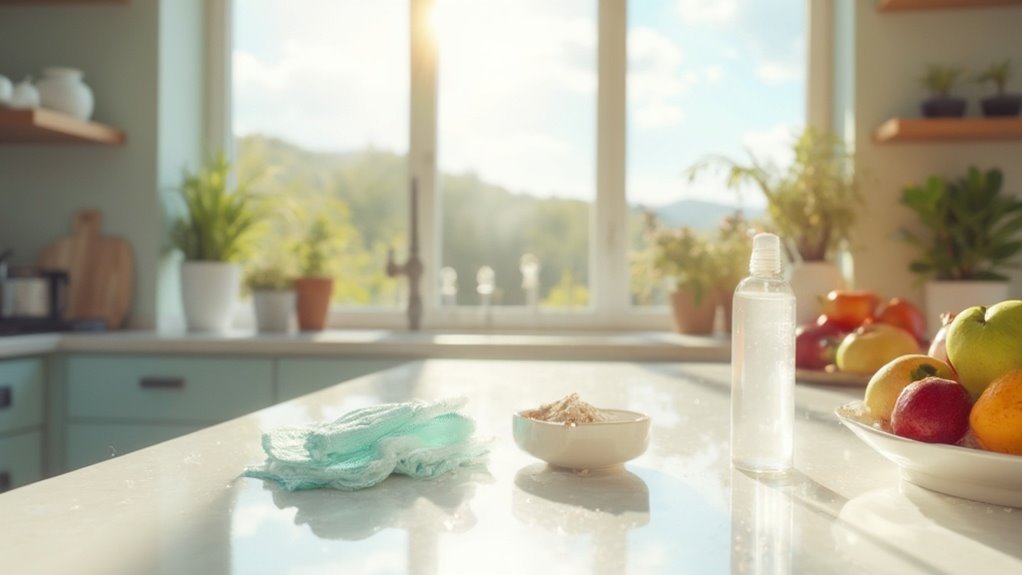
To keep mold at bay, you need to maintain clean and dry surfaces in your home. Regularly dust, mop, and vacuum, focusing on areas prone to moisture, like bathrooms and kitchens. Furthermore, act quickly to clean up spills and address any water damage to prevent mold from taking hold.
Regular Cleaning Habits
Maintaining clean and dry surfaces is crucial in the battle against mold growth. Establishing a consistent cleaning schedule helps you eliminate microscopic particles such as mold spores and bacteria, which thrive in dust. Here are three key habits to incorporate into your routine:
- Frequent Dusting: Regularly dust surfaces where mold spores can settle. Don't forget hidden spots like under sinks and behind appliances.
- Immediate Drying: Wipe up spills immediately and hang wet items like towels or bathmats to dry. Allow appliances to dry by leaving doors open after use.
- Use Effective Supplies: Opt for mold-resistant cleaning products with antimicrobial or antifungal properties. Incorporating natural solutions such as vinegar or baking soda can likewise be beneficial.
Immediate Damage Response
When faced with water damage, swift action is vital to prevent mold growth. Your immediate response should focus on locating the moisture source and performing an immediate cleanup. Start by identifying leaks, whether from pipes, roofs, or HVAC systems. Remove standing water with wet-dry vacuums or towels, and dry the area thoroughly with fans and dehumidifiers.
Here's a quick reference table to guide your emergency response:
| Action | Tools Needed | Follow-Up Steps |
|---|---|---|
| Locate moisture sources | Inspection tools | Repair identified leaks |
| Remove standing water | Wet-dry vacuum, towels | Dispose of contaminated items |
| Dry the affected area | Fans, dehumidifiers | Open windows for airflow |
| Clean and disinfect | Detergents, bleach | Use HEPA vacuums for spores |
After cleaning, confirm the area is completely dry to deter mold. Monitor humidity levels and maintain proper ventilation to prevent future issues. Remember, each step you take in your emergency response can greatly reduce the risk of mold growth in your home.
Manage Indoor and Outdoor Drainage
Managing indoor and outdoor drainage is crucial for preventing mold growth in your home. Effective drainage solutions can help you maintain a dry environment, reducing the risk of mold development. Here are three critical steps to reflect upon:
- Clean Pipes and Improve Ventilation: Regularly clean your pipes and drains using a mixture of baking soda and vinegar. Boiling water can likewise help remove mold colonies. Don't forget to ventilate damp areas—open windows and use dehumidifiers to keep humidity levels low.
- Utilize Effective Drainage Systems: Confirm your indoor drainage systems, like Schluter®-KERDI-DRAIN, are installed correctly to avoid moisture pooling. Check that shower floors slope toward drains and maintain these systems to prevent clogs.
- Focus on Outdoor Maintenance: Keep your gutters clear and verify water flows away from your home. Regularly inspect your yard drainage systems to eliminate standing water, which can lead to mold and pest issues.
Reduce Clutter and Organic Materials
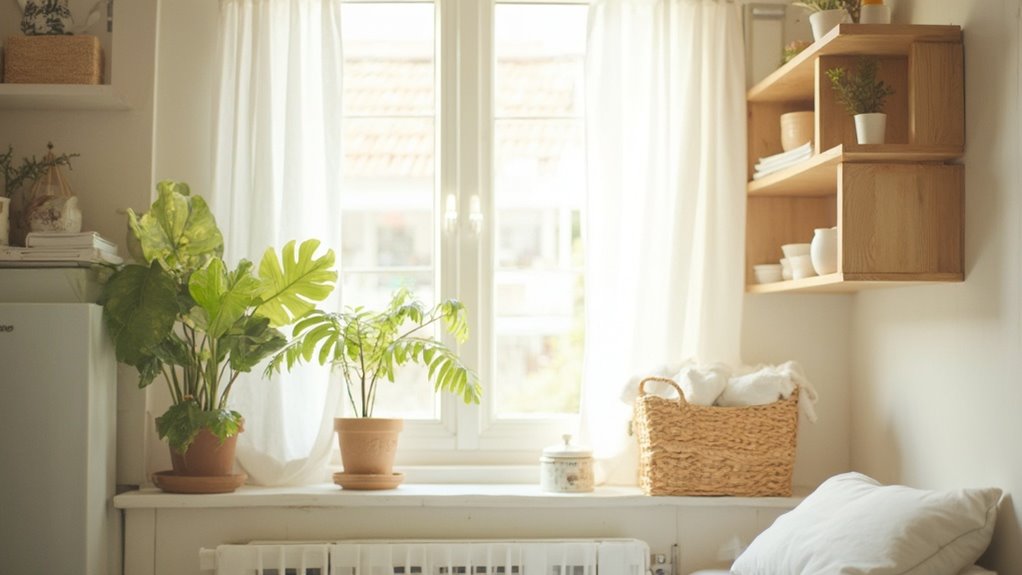
Cutting down on clutter and organic materials is essential to keeping mold at bay in your home. Start by eliminating unnecessary items that block airflow. When organizing spaces, assign each item a designated home, and keep only necessary items. Regularly dust doors, windows, and furniture to prevent dust accumulation, which can trap moisture.
Minimizing clutter likewise extends to your pantry and storage areas. Store paper products in dry, well-ventilated spaces to avoid moisture build-up and consider using digital alternatives for documents. Regularly check for mold on paper items to maintain their condition.
Ensure your clothing is clean and completely dry before storing it, and manage kitchen items by checking expiration dates and keeping surfaces clean. For plants, choose those that absorb moisture and avoid overwatering. Good ventilation is fundamental in plant areas too.
Finally, dedicate time to monitor pet areas by keeping them clean and ensuring they remain dry. By following these practical tips for reducing clutter and organic materials, you'll create an environment less favorable to mold growth, allowing your home to stay healthy and comfortable.
Use Preventative Tools
Creating a mold-resistant environment goes beyond reducing clutter and organic materials; it also involves utilizing preventative tools that actively combat moisture. Implementing these devices can greatly lower the risk of mold growth in your home:
- Dehumidifier Placement: Position dehumidifiers in humid areas like basements, bathrooms, and kitchens. These devices keep relative humidity below 50%, creating an unfavorable environment for mold. Monitor humidity levels with a hygrometer to guarantee peak performance.
- Smart Thermostat Integration: Use smart thermostats to manage indoor humidity levels effectively. They can adjust cooling and heating cycles based on real-time data, allowing you to set specific humidity thresholds. This proactive approach helps maintain a comfortable and healthy living space.
- Airflow Tools: Consider air movers to increase airflow in moisture-prone areas, aiding in drying out spaces quickly. Improved airflow speeds up evaporation and removes conditions favorable to mold growth.
Regular Maintenance Practices
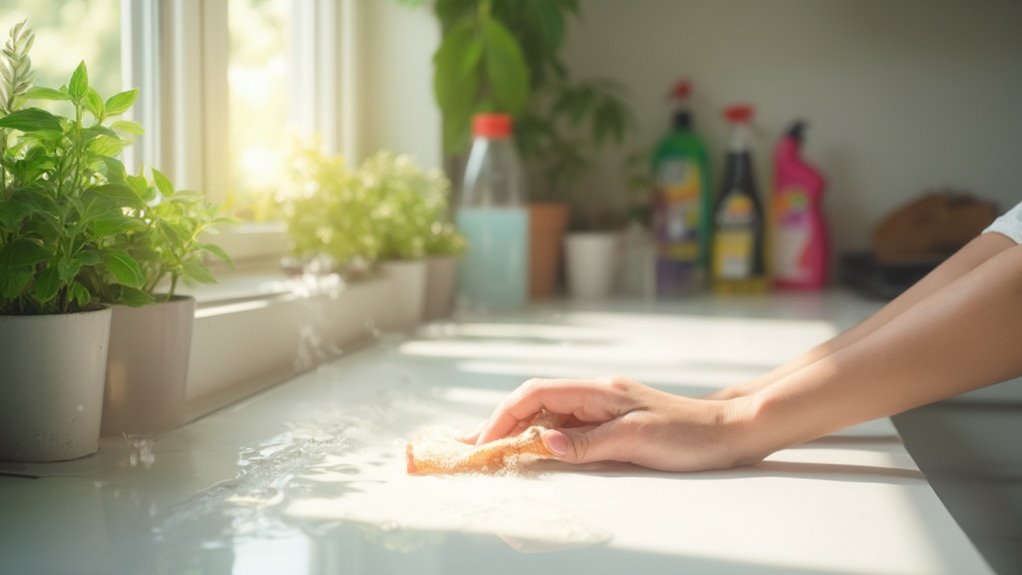
While it might seem intimidating, regular maintenance practices are vital for preventing mold growth in your home. Start with routine inspections of your roof, checking for damaged or missing shingles. Fix any leaks immediately and keep gutters clear to guarantee proper drainage. Seasonal checkups are important; seal openings around windows and doors to prevent moisture intrusion.
Control indoor humidity by keeping levels below 55-60%. Use dehumidifiers in damp areas like basements and bathrooms, and employ air conditioners to reduce moisture effectively. Consider using humidity monitors for real-time readings, and maintain your HVAC systems to manage humidity effectively.
Inspect your plumbing regularly; look for leaks and replace any aging pipes. Insulate pipes in colder areas to prevent condensation. Additionally, maintain water-using appliances, replacing damaged hoses promptly.
Guarantee adequate air circulation and ventilation throughout your home. Use fans, open windows, and rearrange furniture to promote airflow. Install high-quality exhaust fans in kitchens and bathrooms, and clean them regularly to remove excess moisture.
Conclusion
By taking these proactive steps, you can create a mold-free sanctuary in your home. Think of your house as a garden; just as a gardener nurtures plants by controlling water and sunlight, you too must manage moisture and airflow. Regularly inspecting and maintaining your space is like pruning—remove the excess to encourage growth. Stay vigilant, and you'll cultivate a healthy environment where mold can't thrive, ensuring your home remains a safe haven for you and your loved ones.



